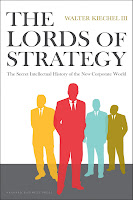Some years back, an attack on managment theory was published under the name of Fad Surfing in the Boardroom, by Eileen Shapiro. The book's main idea was that management consultants ran a racket in which they got gullible corporate executives to regularly shake up their organizations by pursuing one buzzword-laden management fad after another -- often to little avail.
Now comes The Lords of Strategy: The Secret Intellectual History of the New Corporate World by former Fortune managing editor Walter Kiechel III. This book's attitude toward consultants' theories is diametrically different. The Lords of Strategy is largely an intellectual history of management thinking, not so different in character from such U.S. history books as Louis Menand's The Metaphysical Club or Louis Hartz's The Liberal Tradition in America. Kiechel isn't always worshipful of the consultants' ideas, but he does offer a framework in which one year's analysis seems to stand on the shoulders of a previous season's ideas. In other words, the strategic theories are viewed as far from a bunch of scattered and superficial fads.
I learned a lot from Kiechel's well-written, thoughtful volume. But overall, it didn't leave me feeling particularly good about "corporate strategy," which the author sometimes terms "Greater Taylorism." Scientific management tends to treat employees as a means rather than an end -- as easily replaced cogs in the works. We're all easily replaced, as our current 10% unemployment rate attests. For my complete review go to: http://www.dailyfinance.com/story/media/books-dailyfinance-management-theory-to-the-rescue-in-the-lords/19438359/
Friday, April 16, 2010
Thursday, April 1, 2010
Time to Bust Up the Mega-Banks?
Did the recent financial meltdown reveal that the U.S. was a lot like a Third World economy -- like, say, Indonesia in the 1990s, when connections to the ruling elite were all important to enterprises that wanted to prosper?
Consider this analysis of the recent Wall Street bailout from former International Monetary Fund chief economist Simon Johnson: “Washington has behaved like an emerging market government in the 1990s – using public resources to protect a handful of large banks with strong political connections.”
Johnson and his co-author James Kwak, celebrated bloggers with "The Baseline Scenario" (http://baselinescenario.com/) and now with The Huffington Post, have just published a cri de coeur to bust up this cozy political arrangement, which the authors say extends to both major political parties. In 13 Bankers: The Wall Street Takeover and the Next Financial Meltdown (Pantheon, $26.95) the authors argue: “If you hid the name of the country and just showed them the numbers, there is no doubt what old IMF hands would say: nationalize troubled banks and break them up as necessary.”
Socialism! Anarchism! And shades of Alan Greenspan, who not so long ago commented that if some banks today are "too big to fail...they're too big."
So what would be an acceptable size for the six megabanks (Bank of America, JP Morgan Chase, Citigroup, Wells Fargo, Goldman Sachs, and Morgan Stanley)? These authors say none should probably have assets exceeding 4% of GDP, or roughly $570 billion in assets, and no more than 2% of GDP, or $285 billion, in the case of investment banks. Pretty reasonable I'd say.
For my full review go to: http://www.dailyfinance.com/story/books-daily-finance-too-big-to-fail-too-big/19422136/
Consider this analysis of the recent Wall Street bailout from former International Monetary Fund chief economist Simon Johnson: “Washington has behaved like an emerging market government in the 1990s – using public resources to protect a handful of large banks with strong political connections.”
Johnson and his co-author James Kwak, celebrated bloggers with "The Baseline Scenario" (http://baselinescenario.com/) and now with The Huffington Post, have just published a cri de coeur to bust up this cozy political arrangement, which the authors say extends to both major political parties. In 13 Bankers: The Wall Street Takeover and the Next Financial Meltdown (Pantheon, $26.95) the authors argue: “If you hid the name of the country and just showed them the numbers, there is no doubt what old IMF hands would say: nationalize troubled banks and break them up as necessary.”
Socialism! Anarchism! And shades of Alan Greenspan, who not so long ago commented that if some banks today are "too big to fail...they're too big."
So what would be an acceptable size for the six megabanks (Bank of America, JP Morgan Chase, Citigroup, Wells Fargo, Goldman Sachs, and Morgan Stanley)? These authors say none should probably have assets exceeding 4% of GDP, or roughly $570 billion in assets, and no more than 2% of GDP, or $285 billion, in the case of investment banks. Pretty reasonable I'd say.
For my full review go to: http://www.dailyfinance.com/story/books-daily-finance-too-big-to-fail-too-big/19422136/
Subscribe to:
Posts (Atom)





